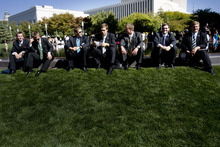This is an archived article that was published on sltrib.com in 2012, and information in the article may be outdated. It is provided only for personal research purposes and may not be reprinted.
Saturday was supposed to be about NCAA football for Southern Utah University President Michael Benson.
But news out of The Church of Jesus Christ of Latter-day Saints promptly changed the subject less than three hours before the Thunderbirds' kickoff against Sacramento State.
Instead of boasting about the mighty arm of quarterback Brad Sorenson, Benson spent the morning fielding questions from trustees and alumni about how reduced ages for missionary service will affect the Cedar City school.
"I had more questions about it than I knew how to handle," Benson said. "We're in the nascent stages of trying to figure out what policies we can come up with to accommodate them. It will impact our recruiting and scholarship policies."
He also expects a dip in enrollment next semester if many students, who now qualify for Mormon missions under the new policy, opt to leave school. Currently, nearly a fifth of SUU's freshman class leaves on missions each year.
—
At last weekend's General Conference in Salt Lake City, church leaders announced they were lowering the minimum mission age from 21 to 19 for women and from 19 to 18 for men. The policy change, which takes immediate effect, is expected to have a profound influence on college life across Utah, whose universities bid a temporary farewell each year to thousands of students answering the call of their church. Now faithful Mormon men can embark on two-year tours of proselytizing duty right out of high school (women go for 18 months), but it is unclear how many will choose to do that.
"How much of an impact we don't know yet. The presidents are working with their Cabinets to explore what it means for their schools," said Dave Buhler, Utah's commissioner of higher education. "We have a lot more questions than answers. It was encouraging that there were a number of references [by Mormon leaders] to the importance of completing college."
—
The LDS Church's announcement comes at a time when Utah's public universities are amping up their efforts to retain students and improve graduation rates. Opinions are mixed on whether younger mission service will hinder or help these goals.
Breaks that slow students' progress generally are seen as obstacles to graduation, but missionary service often equips students with discipline, a broader view of the world and a second language — qualities and skills that promote college success.
"We know from a lot of national data the best thing for them academically is to enroll in higher education as soon as possible after high school," Buhler said. "On the other hand, the mission experience can have a good effect on them deciding to get into higher education."
Susan Madsen, a Utah Valley University management professor who heads the state's Women and Education Project, believes the new LDS policy could improve college completion rates among Mormon women.
"It is one of the best developmental experiences for women," Madsen said. "They learn how to work, they learn how to learn, they learn how important an education can be."
Madsen herself interrupted her studies at LDS Church-owned Brigham Young University in the early 1980s to serve an 18-month mission in Florida.
—
No Utah school will feel the impact more than Madsen's alma mater, where at least 90 percent of male undergraduates and about 20 percent of females serve missions before graduating.
"We are excited about this announcement and what it means for the young adults of the church, including our BYU students," officials said in a prepared statement. "Although there are questions we cannot answer immediately, we will be looking closely at how our students and prospective students respond to this change. We are confident that we will be able to continue to provide all of our students with a superb educational experience."
SUU and Utah's other public universities will have to adjust their admissions policies to accommodate mission-bound Mormons who want a two-year deferment before starting college.
Officials don't expect those changes to be controversial. But schools will have to work even more closely with their returned LDS missionaries since many will have less college experience when they get home, according to Barbara Snyder, the University of Utah's associate vice president for student affairs.
"The biggest concern," she said, "is that when they return, they are ready for us and we are ready for them."
—
High-achieving high-school grads going on missions will also have to be careful about safeguarding scholarship offers.
Buhler stressed that such students would not be jeopardizing their Regents' Scholarship "as long as they let us know what they are doing" and provide documentation of their church service. This state-funded stipend worth up to $5,000 normally requires students to start college within a year of high school graduation.
Selective schools typically are open to granting a "gap year" to admitted students, giving them time after high school to experience life. But the two years of service required of an LDS man on a mission might test the flexibility at many of the nation's top universities.
At the University of California, Los Angeles, among the Golden State's most selective public schools, such requests are decided case by case — whether the gap is for the standard one year or for two years, according to university spokesman Ricardo Vazquez.
SUU's Benson said he hopes elite schools will see that missionary experience will enable applicants to bring greater maturity and study skills to their campuses.
He suspects many college-bound students could be better off completing their church service out of high school.
That way they avoid breaking up their college studies and arrive at school with greater confidence.
Benson cited his nephews who attended the U.S. Air Force Academy, but could not graduate with the cadets they started with because they left Colorado Springs for two-year missions.



